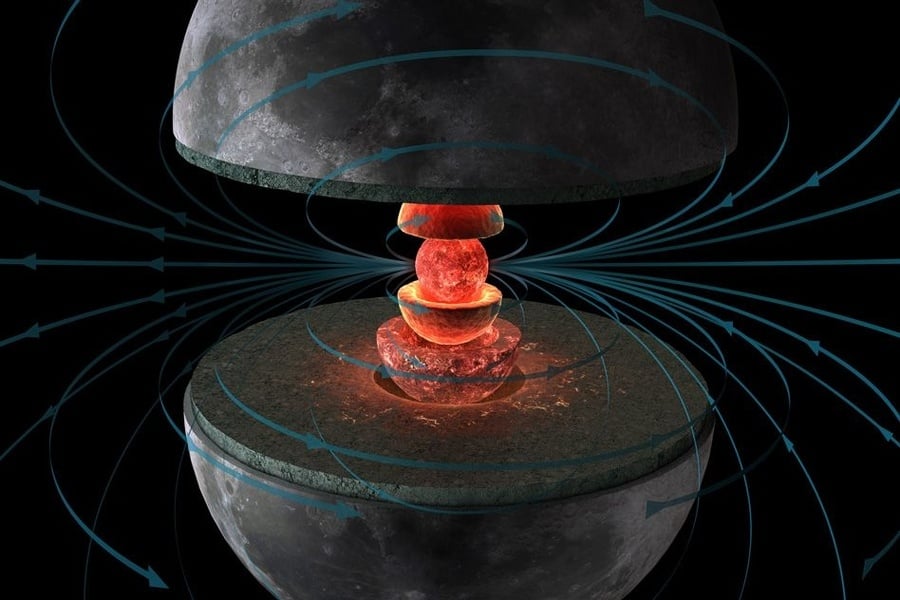When it comes to the study of planets, moons, and stars, magnetic fields are kind of a big deal. Believed to be the result of convection in a planet, these fields can be the difference between a planet giving rise to life or becoming a lifeless ball of rock. For some time, scientists have known that has a Earth's magnetic field, which is powered by a dynamo effect created by convection in its liquid, outer core.
Scientists have also long held that the Moon once had a magnetic field, which was also powered by convection in its core. Previously, it was believed that this field disappeared roughly 1 billion years after the Moon formed (ca. 3 to 3.5 billion years ago). But according to a
new study
from the Massachusetts Institute of Technology (MIT), it now appears that the Moon's magnetic field continued to exist for another billion years.
The study, titled "
A two-billion-year history for the lunar dynamo
", recently appeared in the journal
Science Advances
. Led by Dr. Sonia Tikoo, an Assistant Professor at Rutger's University and a former researcher at MIT, the team analyzed ancient lunar rocks collected by NASA's
*Apollo 15*
mission. What they found was that the rock showed signs of a being in magnetic field when it was formed between 1 and 2.5 billion years ago.
[caption id="attachment_63584" align="aligncenter" width="580"]
Artist's concept of a collision between proto-Earth and Theia, which led to the formation of Moon, ca. 4.5 billion years ago. Credit: NASA
[/caption]
The age of this rock sample means that it is significantly younger than others returned by the Apollo missions. Using a technique they developed, the team examined the sample's glassy composition with a magnometer to determine its magnetic properties. They then exposed the sample to a lab-generated magnetic field and other conditions that were similar to those that existed on the Moon when the rock would have formed.
This was done by placing the rocks into a specially-designed oxygen-deprived oven, which was built with the help of Clement Suavet and Timothy Grove - two researchers from MIT's Department of
Earth, Atmospheric and Planetary Sciences
(EAPS) and co-authors on the study. The team then exposed the rocks to a tenuous, oxygen-free environment and heated them to extreme temperatures.
As Benjamin Weiss - a professor of planetary sciences at EAPS - explained:
From this, they determined the lunar rock became magnetized in a field with a strength of about 5 microtesla. That's many times weaker than Earth's magnetic field when measured from the surface (25 - 65 microteslas), and two orders of magnitude weaker than what it was 3 to 4 billion years ago. These findings were quite significant, since they may help to resolve an enduring mystery about the Moon.
[caption id="attachment_135039" align="aligncenter" width="580"]
Cutaway of the Moon, showing its differentiated interior. Credit: NASA/SSERVI
[/caption]
Previously, scientists suspected that the Moon's magnetic field died out 1.5 billion years after the Moon formed (ca. 3 billion years ago). However, they were unsure if this process happened rapidly, or if the Moon's magnetic field endured, but in a weakened state. The results of this study indicate that the magnetic field did in fact linger for an additional billion years, dissipating about 2.5 billion years ago.
As Weiss indicated, this study raises new questions about the Moon's geological history:
In other words, this new timeline of the Moon casts some doubt on the theory that a lunar dynamo alone is what powered its magnetic field in the past. Basically, it is now seen as a distinct possibility that the Moon's magnetic field was powered by two mechanisms. Whereas one allowed for a dynamo in the core that powered its magnetic field for a good billion years after the Moon's formation, a second one kept it going afterwards.
In the past, scientists have proposed that the Moon's dynamo was powered by Earth's gravitational pull, which would have caused tidal flexing in the Moon's interior (much in the same way that Jupiter and Saturn's powerful gravity drives geological activity in their moons interiors). In addition, the Moon once orbited much closer to Earth, which may have been enough to power its once-stronger magnetic field.
[caption id="attachment_118542" align="aligncenter" width="580"]
Artist's impression of a Mars-sized object crashing into the Earth, starting the process that eventually created our Moon. Credit: Joe Tucciarone
[/caption]
However, the Moon gradually moved away from Earth, eventually reaching its current orbit about 3 billion years ago. This coincides with the timeline of the Moon's magnetic field, which began to dissipate at about the same time. This could mean that by about 3 billion years ago, without the gravitational pull of the Earth, the core slowly cooled. One billion years later, the core had solidified to the point that it arrested the Moon;s magnetic field. As Weiss explained:
These findings were made possible thanks in part by the availability of younger lunar rocks. In the future, the researchers are planning on analyzing even younger samples to precisely determine where the Moon's dynamo died out completely. This will not only serve to validate the findings of this study, but could also lead to a more comprehensive timeline of the Moon's geological history.
The results of these and other studies that seek to understand how the Moon formed and changed over time will also go a long way towards improving our understanding of how Earth, the Solar System, and extra-solar systems came to be.
Further Reading: Science Advances
,
*MIT News*
 Universe Today
Universe Today
